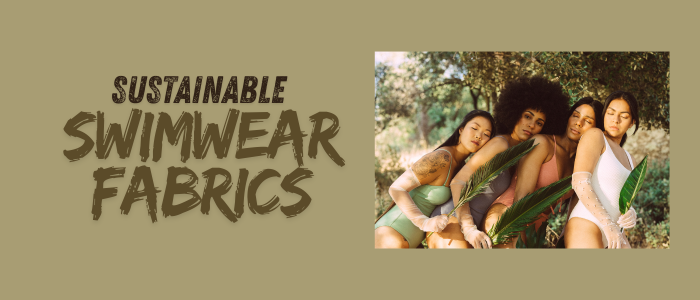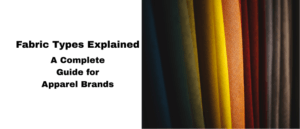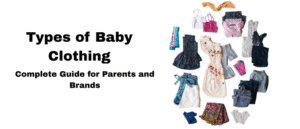The fashion industry is undergoing a major shift toward sustainability, and swimwear is no exception. With growing awareness of plastic pollution and climate change, brands and consumers are rethinking the fabrics behind their favorite swimsuits. Eco-friendly swimwear fabrics not only reduce environmental impact but also help brands stand out in a competitive, eco-conscious market.
The swimwear market is undergoing a major transformation. In 2022, the global sustainable swimwear market was valued at US $7.8 billion and is projected to more than double to $16.2 billion by 2032, with a steady CAGR of 7.7%—a clear sign that demand for eco-conscious swimwear is surging.
For startups, designers, and established swimwear brands, choosing the right sustainable swimwear fabrics is essential. In this guide, we’ll explore the best eco-friendly materials, certifications to look for, sourcing tips, and how Argus Apparel, a private label manufacturer, can support your brand in producing sustainable swimwear collections.
Why Choose Sustainable Swimwear Fabrics?
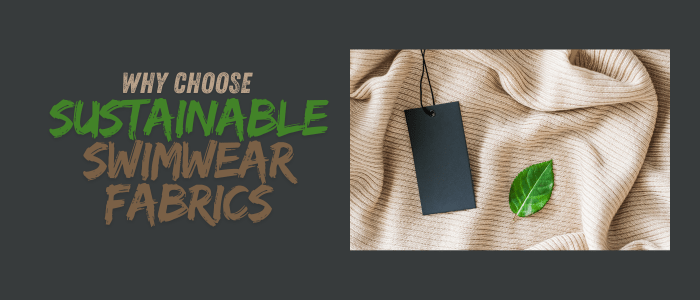
Swimwear has traditionally been made from synthetic fibers like nylon and polyester. These materials are derived from petroleum-based plastics, which means every bikini or swimsuit made from them carries a heavy environmental footprint. While they provide performance benefits such as stretch, durability, and quick-drying properties, their downsides are significant:
- Plastic pollution and microfiber shedding:
Every time synthetic swimwear is washed, it sheds tiny plastic fibers. According to research, a single load of laundry can release up to 700,000 microfibers into waterways, contributing to ocean pollution and threatening marine life.
- Dependence on fossil fuels:
The production of nylon and polyester requires large amounts of crude oil and energy. Nylon alone has one of the highest energy footprints of any textile, releasing 5.4 kg of CO₂ emissions per kilogram produced.
- Non-biodegradability:
Conventional fabrics take 200–500 years to decompose in landfills, meaning every piece of synthetic swimwear ever produced still exists somewhere on the planet.
On the other hand, switching to eco-friendly swimwear materials offers both environmental and business benefits.
The Consumer Shift Toward Sustainability
Today’s consumers are far more eco-conscious than in previous decades. A McKinsey survey found that 67% of shoppers consider sustainable materials an important factor in their purchasing decisions. In swimwear, where the link to oceans and beaches is direct, this awareness is even stronger. Over 70% of consumers say they are willing to pay more for eco-friendly swimwear options.
Also check: Guide to Bra Types
Brand Opportunity
For swimwear startups, private labels, and established fashion houses, the shift toward sustainability is not just a responsibility, it’s a market advantage. Choosing sustainable swimwear fabrics allows brands to:
- Align with customer values:
By offering recycled or organic fabrics, brands signal a commitment to protecting oceans and reducing waste.
- Differentiate in a crowded market:
With the global swimwear industry worth $21.2 billion in 2024 and growing, sustainability provides a unique selling point that sets brands apart from competitors relying on traditional synthetics.
- Build long-term brand loyalty:
Eco-conscious shoppers are more likely to stick with brands that reflect their values, leading to stronger repeat purchase behavior and word-of-mouth marketing.
Best Sustainable Swimwear Fabrics
The swimwear industry is rapidly innovating with eco-friendly swimwear materials that combine performance, comfort, and environmental responsibility. These fabrics provide brands with the flexibility to create stylish, durable, and planet-friendly collections. Below are the most effective alternatives to traditional synthetics.
Recycled Nylon (Econyl®)
The most recognized material in the sustainable swimwear space, Econyl® is a regenerated nylon created from pre- and post-consumer waste such as abandoned fishing nets, carpet fibers, and industrial plastic scraps. Through an advanced regeneration process, the waste is purified and transformed back into nylon with the same quality as virgin nylon.
Key Features:
- Durable and long-lasting: Retains strength and elasticity over time.
- Excellent stretch and recovery: Ensures swimwear maintains its shape even after repeated use.
- Quick-drying and lightweight: Offers the performance benefits brands and consumers expect.
- Closed-loop production: Econyl® can be recycled infinitely, reducing the need for virgin nylon production.
Best For: High-performance swimwear, luxury swimwear brands, and activewear collections. Many premium eco-friendly swimwear labels now rely heavily on Econyl® as their core fabric.
Recycled Polyester (rPET)
Another widely adopted fabric, recycled polyester (rPET) is made from post-consumer PET bottles and sometimes industrial polyester waste. Instead of ending up in oceans or landfills, plastic bottles are cleaned, shredded, and spun into high-quality polyester fibers.
Key Benefits:
- Strong and lightweight: Offers durability while keeping garments comfortable.
- Reduces plastic waste: Keeps millions of plastic bottles out of oceans and landfills.
- Lower carbon footprint: Requires 59% less energy to produce than virgin polyester.
- Versatile for blends: Often combined with elastane or spandex for greater stretch.
Best For: Everyday swimwear collections, mid-range to premium brands, and startups looking for an affordable yet sustainable option.
Organic Cotton Blends
While not suitable for water-intensive performance swimwear on its own, organic cotton is ideal for related categories such as beachwear, cover-ups, and casual swim fashion. Unlike conventional cotton, organic cotton is grown without harmful pesticides and uses up to 91% less water.
Why Choose Organic Cotton?
- Naturally biodegradable and chemical-free: Safer for the environment and the wearer.
- Gentle on skin: Breathable and hypoallergenic, flawless for sensitive skin.
- Flexible with blends: When mixed with elastane, organic cotton offers added stretch while remaining eco-friendly.
Best For: Sustainable beach dresses, resort wear, and casual swimwear fashion.
Hemp & Linen Blends
Hemp and linen are ancient fibers that are making a strong comeback in sustainable fashion. Both are highly renewable, require minimal water, and grow quickly without chemical fertilizers or pesticides.
Why They Stand Out:
- Extremely eco-friendly: Hemp enriches the soil it grows in, and linen (made from flax) thrives in cooler climates with minimal input.
- Durable and breathable: Provide a natural, textured feel with excellent air circulation.
- Timeless look: Offer a relaxed, earthy aesthetic that resonates with eco-conscious consumers.
Best Uses: Resort wear, relaxed beach cover-ups, and casual swim fashion pieces where comfort and style outweigh high elasticity.
Plant-Based Alternatives (Tencel & Bamboo)
Innovative plant-based fabrics like Tencel (Lyocell) and bamboo are becoming popular for eco-conscious apparel. Tencel is produced from sustainably sourced wood pulp, while bamboo fabric is derived from the fast-growing bamboo plant. Both undergo environmentally responsible production processes.
Key Advantages:
- Renewable and biodegradable: Made from plants that naturally replenish themselves.
- Soft and breathable: Extremely comfortable and gentle on skin, making them great for hot climates.
- Eco-friendly processing: Tencel is produced in a closed-loop system where 99% of solvents are reused.
Best For: Lightweight swimwear, resort wear, loungewear, and cover-ups. While not ideal for performance swimsuits, they provide a sustainable choice for complementary pieces in a swimwear collection.
Conventional vs. Sustainable Swimwear Fabrics
| Fabric Type | Origin | Environmental Impact | Performance Features | Best Use in Swimwear |
|---|---|---|---|---|
| Nylon (Conventional) | Petroleum-based synthetic | High carbon footprint, sheds microplastics, non-biodegradable (200–500 years to decompose) | Stretchy, durable, quick-dry | Traditional swimsuits |
| Polyester (Conventional) | Petroleum-based synthetic | Energy-intensive, relies on fossil fuels, contributes to plastic waste | Strong, lightweight, versatile | Swimwear blends, sportswear |
| Recycled Nylon (Econyl®) | Regenerated from fishing nets, fabric waste, plastics | Reduces ocean waste, infinitely recyclable | Durable, stretchy, lightweight | Performance swimwear, activewear |
| Recycled Polyester (rPET) | Made from post-consumer PET bottles | Cuts energy use by ~59%, diverts plastic from landfills | Strong, lightweight, versatile | Everyday swimwear, mid-range collections |
| Organic Cotton Blends | Grown without pesticides; blended with elastane | Biodegradable, up to 91% less water than conventional cotton | Soft, breathable, flexible (when blended) | Beachwear, cover-ups, casual swim fashion |
| Hemp & Linen Blends | Natural plant fibers | Low water use, minimal chemicals, enriches soil | Durable, breathable, natural texture | Resort wear, casual swimwear |
| Tencel & Bamboo | Plant-based, renewable sources | Biodegradable, closed-loop production for Tencel | Soft, breathable, gentle on skin | Lightweight swimwear, loungewear, cover-ups |
Certifications to Look for in Sustainable Fabrics
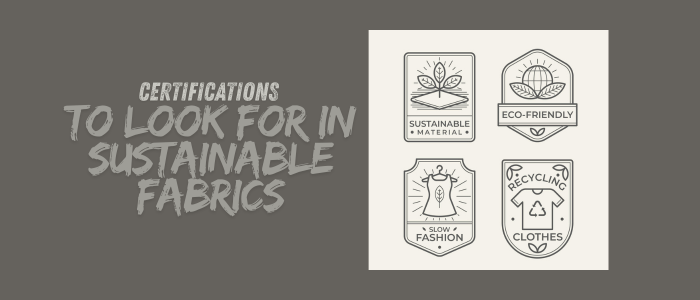
When sourcing sustainable swimwear fabric suppliers, certifications are crucial to ensure authenticity and transparency. Choosing certified fabrics helps brands build trust with eco-conscious consumers. Key certifications include:
- GRS (Global Recycled Standard): Verifies recycled content and sustainable practices.
- OEKO-TEX Standard 100: Ensures fabrics are evaluated for harmful substances.
- GOTS (Global Organic Textile Standard): Certifies organic fibers and ethical production.
How to Source Sustainable Swimwear Fabrics for Your Brand
Sourcing the right fabrics can be challenging, especially for startups and small labels. Investing in the best fabrics for eco-friendly swimwear not only strengthens sustainability efforts but also enhances your market positioning. Here are some key points to consider:
- Resolute Suppliers: Work with sustainable swimwear fabric suppliers who provide transparency about sourcing and certifications.
- MOQ (Minimum Order Quantities): Small brands should look for suppliers and manufacturers offering low MOQ options.
- Cost vs. Value: While eco-friendly fabrics may cost more upfront, they increase long-term brand value and customer loyalty.
Argus Apparel – Your Partner for Sustainable Swimwear Manufacturing
At Argus Apparel, we help fashion brands turn their eco-conscious vision into reality. Whether you’re a new swimwear startup or an established label, our team ensures your products are stylish, high-quality, and environmentally responsible.
As a trusted manufacturer, we provide:
- Access to premium sustainable fabrics such as Econyl®, rPET, organic cotton blends, and more.
- Custom swimwear designs tailored to your brand’s style, with eco-friendly production methods.
- Low MOQ support for startups and small labels entering the sustainable swimwear market.
Conclusion
Sustainable swimwear fabrics are no longer a niche trend—they’re the future of fashion. By choosing materials like recycled nylon, rPET, and organic blends, brands can reduce their environmental footprint while appealing to the growing base of eco-conscious consumers.
If you’re ready to build your collection with eco-friendly swimwear materials, Argus Apparel is here to help.
Contact us today to create your sustainable swimwear collection.

